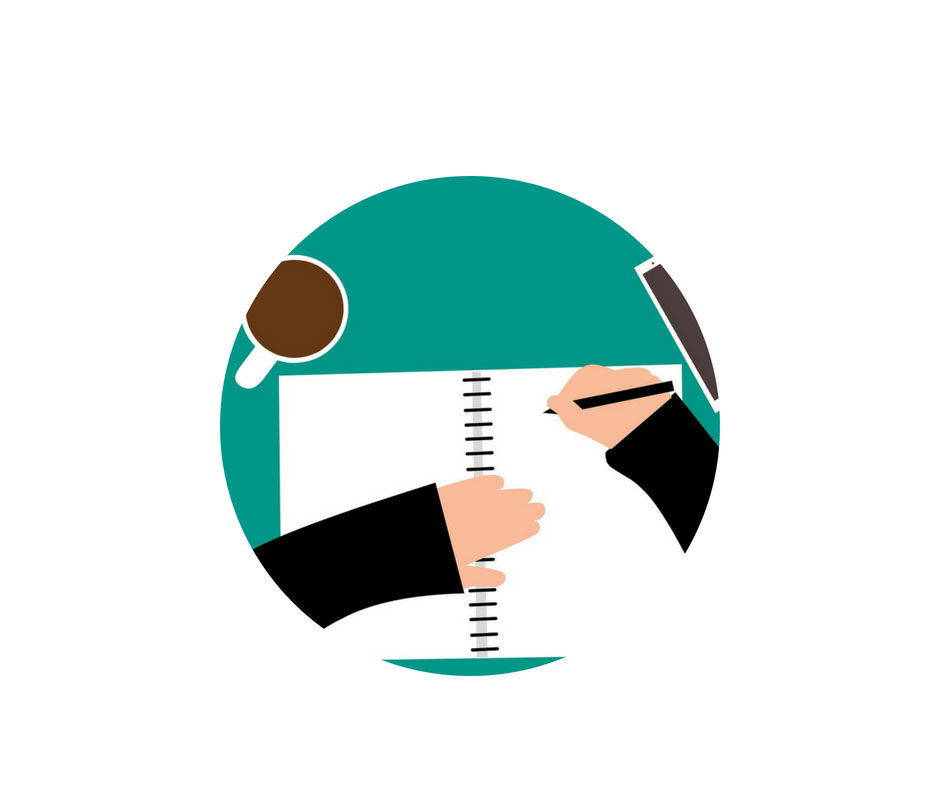Written by Jes Gonzalez
Whether you've drafted an academic paper, a creative piece of writing, or a business document, it needs to be edited and proofread. In fact, no piece of writing is complete if it hasn't been through the revision process.
Good writing is almost always the result of good editing. Think of it this way: if your writing were a clay pot, the editing process would be the kiln firing to unify it before it is presented as a final, polished product.

Our Expert Editing Tip: Good writing is almost always the result of good editing.
The biggest question we all have is how to edit and proofread our own writing to ensure that it is clear, correct, and consistent throughout, as these elements are vital to ensure that you establish authority with your audience and communicate your message clearly.
In this post, I'm going to share the key steps to editing and proofreading your own writing with a convenient and effective checklist.
Do you have basic knowledge of the English language, including paragraph structure, sentence construction, and word choice?

Then let's begin so you can learn how to edit and proofread your own writing, step by step. Typically, when editing, it is best to conduct a first pass (to catch major errors), a second pass (to catch minor errors), and a final proofread (to ensure perfection throughout). Below is the outline we will be following.
1. Conduct a First Pass
1.1. Ensure effective organization.
1.3. Check for correct mechanics.
1.4. Ensure clarity and concision.
1.5. Make sure everything is punctuated correctly.
1.6. Follow the conventions of the type of English.
1.7. Review the citations and references.
1.8. Ensure consistent formatting.
1.9. Check the figures and tables.
1.10. Check the lists and equations.
1.11. Refer to any specific instructions.
1.12. Provide yourself with substantive feedback.
Intermission: Coffee Break!
2. Conduct a Second Pass
3. Conduct a Final Proofread
Let's start with the first pass!
1. Conduct a First Pass
1.1. Ensure effective organization.
Writing must be well organized to be effective. First drafts generally require reorganization to ensure that the message is presented in the most logical and clear way. To start, you'll need to consider the type of document you are writing. For example, the structure of a book in a series will be much different from the structure of a persuasive essay.

Our Expert Editing Tip: Each type of writing follows its own conventions,
so it's important that you review these before you attempt to apply conventional organization.
Zooming in, you'll also want to check that each paragraph is well structured. Paragraphs follow their own conventional structure, typically beginning with a topic sentence. In addition, each paragraph is structured somewhat differently based on its location in the paper (e.g., the introductory paragraph will be structured differently from a body paragraph). Check each paragraph to ensure the correct structure is applied.
Finally, check the headings and lists. If your piece of writing has headings and lists, be sure their formatting follows your preferred or required style guide. You'll also want to ensure that the headings are clear on their own and that list items are organized effectively (e.g., by order of importance or sequentially). If your piece of writing lacks headings or lists, reconsider. Would separating some information under different headings help to make the piece clearer? Or would any sections benefit from a list outlining steps or important points? Create an outline to help you best structure your writing. For example:
ü Main topic
o Subtopic
§ Detail
o Subtopic
§ Detail

Flow and tone may be the hardest elements to master, especially if English is not your first language. However, for a native English writer, problems with either can usually be detected by reading the piece out loud. Any awkward sentence constructions can be caught in this way, and you should be able to smooth them out. Use this method to check the sentence variety as well.

Our Expert Editing Tip: Too many short or long sentences in a row can be distracting for readers.
Consider the following sentence from this post:
× As black ink is not harmful to geese, and the color students use the most when printing college admission essays is black, students should be required to print their essays in only black ink to protect the health of geese, and cities should run programs to educate students about the dangerous food preferences of geese, as vicious geese often attack students if they smell college admission essays.
See how confusing sentences can be if they are too long? That's why you'll want to vary your sentence structure. To further improve flow, check the transitions between paragraphs and sentences. Each paragraph should flow into the next, and the ideas should connect and make sense in succession. The same is true on the sentence level. Check that your sentences make sense when read together and not just one at a time.
You'll also need to consider your context and audience for this step. The context, be it academic, creative, personal, or professional, should influence how you've written the piece; if it hasn't, it would be best to revise accordingly. The same is true for the audience. When you're writing an email to a colleague, it will probably sound very different from when you're texting a close friend. Identify your target audience now and keep it in mind while you review your writing.
1.3. Check for correct mechanics.

Unlike flow and tone, mechanics are not difficult to learn, but there is a lot to cover. An automatic spell-checker can be helpful in catching these types of problems, so run one to catch any typos or obvious grammatical errors. However, keep in mind that automatic spell-checkers are not perfect, and you will still need to review your writing word by word to ensure that the spelling and grammar are perfect.
While reviewing, make sure that the tense and voice are consistent throughout. Switching them around will definitely cause confusion in any type of writing. You'll also want to complete any unfinished sentences and correct any subject–verb disagreement because both are distracting for readers and signal that your draft remains unfinished. For example:
× Duck like water.
ü Ducks like water.
In addition, be sure to review your vocabulary based on the type of writing and the intended audience.

Our Expert Editing Tip: Remove any jargon and clarify word choices that may be incorrect or unfamiliar to the reader.
On the same note, if you've used any acronyms, make sure that you've defined them on their first use so the reader can follow along and that you've used them consistently throughout to prevent confusion. If an acronym is used only once, give the full term instead.
1.4. Ensure clarity and concision.

To ensure clarity throughout your writing, be sure to check the actual content for a logical flow. If the writing is a bit incoherent as a whole, rearrange, add, or remove the necessary sections. Also be sure to review your arguments and statements for clarity.

Our Expert Editing Tip: If there's any area where you think you could elaborate or be more specific, be sure to do so.
Consider the following sentence:
× The subjects were recruited from a hospital.
Do you see what's wrong with it? The problem is the sentence is too vague. How many subjects? Subjects of what? When were the subjects recruited? At which hospital? Where is the hospital located? Consider all the questions a reader might have and answer them before they can be asked. The revised sentence might read something like this:
ü The 42 subjects of our study on diabetes were recruited in August 2017 from University Hospital in Sweden.
In terms of concision, you'll want to ensure that any redundancy in the content is removed. If you've already covered a topic, there's no need to cover it again. In addition, you'll want to check that the wording is not too repetitive. For example, if you find you've used the same transition in two sentences in a row, you'll want to replace one of them. Finally, check for wordiness; remember that less is more.
1.5. Make sure everything is punctuated correctly.

Although punctuation falls under mechanics, there are quite a few specific punctuation issues to check. First, depending on the type of document, exclamation marks and ellipses may need to be removed. In addition, use italics for emphasis rather than quotation marks to avoid introducing scare quotes into the text.
Check your dashes; make sure en dashes are used for numbered ranges and that em dashes are used for parenthetical information. On that note, apply parenthetical commas where appropriate. Be sure to use semicolons instead of commas between independent clauses or in lists containing long phrases. For example:
× The dog barked, he was a good dog.
ü The dog barked; he was a good dog.
Finally, check that colons are used to introduce lists but not after "include" or verbs of being (e.g., "is," "will," "was").
Consistency in punctuation is also important.

Our Expert Editing Tip: Ensure the consistent use of straight or curly punctuation marks throughout as well as the consistent
use of either single or double quotation marks first throughout.
Check that punctuation marks are consistently placed either inside or outside quotation marks (not both!) depending on the type of English (read more on that in the next section). In addition, make sure that hyphenated terms are hyphenated consistently throughout the entire piece of writing. For a list of punctuation rules, click here.
1.6. Follow the conventions of the type of English.
Based on the type of English being used in your writing, you'll need to make certain changes, as different types of English follow different conventions. For example, US English typically uses the Oxford comma, whereas British English typically omits the Oxford comma.

Our Expert Editing Tip: These types of English also follow different conventions for quotation marks
(single or double first) and the placement of punctuation inside or outside quotation marks.
In addition, different types of English follow different spelling conventions (program in US English versus programme in British English) and abbreviation conventions (Dr. in US English and Dr in British English). Finally, numbers and dates follow specific conventions in different regions. See the following:
· US English: MM/DD/YYYY
· British English: DD/MM/YYYY
Note that Canadian and Australian English also follow particular conventions combining rules from British and US English in different ways.
Remember when you determined your context and audience? Now be sure to determine the type of English based on these factors and apply the necessary changes.
1.7. Review the citations and references.

If your writing includes citations and references to outside sources, you'll need to ensure their formatting complies with your preferred or required style guide (e.g., MLA, APA, Chicago, Turabian). If you aren't following a specific style guide, you'll want to ensure consistency throughout, including the in-text citation formatting, the punctuation placement around in-text citations, the reference list heading and formatting, the ordering of references, and the formatting of individual references. For example:
× (Smith, 2017); (Roberts & Daniel 1992); (Ripley, Doherty and Goodman, 2005)
ü (Smith, 2017); (Roberts & Daniel, 1992); (Ripley, Doherty, & Goodman, 2005)
In addition, be sure to cross-check the in-text citations against the reference list. If a reference is missing from the list but is cited in the text, you'll need to add it to the list. You'll also want to make sure that author names are spelled consistently throughout and that the correct years are given consistently throughout. Finally, you'll want to note any information in the text that isn't cited but should be. Be sure to add the necessary reference information to avoid accidental plagiarism.

Our Expert Editing Tip: Even if you've only failed to cite your own work, you could be still accused of plagiarism, so be sure to cite all of your sources.
1.8. Ensure consistent formatting.

What's wrong with the following headings?
1.1 Why do Geese eat College essays?
1.2. The financial burden of treating geese
1.2 Chemicals In Ink
There are a few major issues. The first is that the headings are not numbered correctly. The second is that the capitalization is inconsistent across and even within the headings. The third is that the spacing is inconsistent between the numbers and the headings.

Our Expert Editing Tip: Formatting, although somewhat nitpicky, is important for ensuring readability.
Be sure your formatting follows the conventions of the type of writing and the instructions of your style guide. Check the line justification and spacing; the page margins; the font size, type, and color; the heading and subheading capitalization, numbering, and formatting; and the spacing between sections, chapters, paragraphs, and sentences.
To ensure consistency in all these elements, a style guide can be very helpful. APA style, for example, provides many formatting instructions. Although following a style guide can be a bit tedious, it helps to ensure that you have formatted all elements consistently, so consider implementing one. Overall, remember that consistency is key, as inconsistent formatting is distracting to readers.
1.9. Check the figures and tables.

If your document includes figures and tables, you'll need to review them and their callouts in the text. All tables and figures should be mentioned in the text prior to their placement. In addition, acronyms should generally be avoided in figures and tables as well as in their captions and titles. Check that all references to tables and figures are formatted consistently. For example:
× Fig. 1, Figure 2, Fig 3.
ü Fig. 1, Fig. 2, Fig. 3
Check that tables are formatted consistently in terms of font type, size, and color and in the use of capitalization and justification. In addition, number all table titles consecutively and format the titles consistently in terms of font type, size, and color and in the use of capitalization, numbering, and punctuation.
Also ensure appropriate and consistent figure formatting and justification. Format figure captions consistently in terms of font type, size, and color and in use of capitalization, numbering, and punctuation.

Our Expert Editing Tip: Be sure to note that table titles are generally placed above tables while figure captions are generally placed below figures.
As with many elements of good writing, consistency is key, so ensure all these elements are consistent.
1.10. Check the lists and equations.

Does your document include lists or equations? If so, ensure that they are formatted and numbered consistently throughout. Also check that equations are referred to consistently throughout (e.g., Eq. 1, Eq. 2, Eq. 3 rather than Eq. 1, Equation 2, eq 3). In addition, check that lists are punctuated consistently. Look at the following list:
1. Dogs like to run.
2. Dogs like to chew shoes
3. Like to fetch.
4. Sticks
Do you see what's wrong with the list? The main problem is that it's inconsistent; the first two sentences are full sentences, while the last two are not. In addition, the punctuation is inconsistent. Stick to one format.

Our Expert Editing Tip: Only punctuate lists that contain full sentences.
Here's the revised list:
1. Dogs like to run.
2. Dogs like to chew shoes.
3. Dogs like to fetch.
4. Dogs like to play with sticks.
See how much better this looks?
1.11. Refer to any specific instructions.

Did you have any specific instructions to follow in drafting your document, such as journal guidelines or assignment instructions? If so, be sure you've followed them to a tee. This may include ensuring that the target word count has been met or that the requested formatting has been followed.
· If your guidelines require a 1,000-word maximum, do not go a word over!
Following specific instructions may also mean ensuring that you have answered the necessary questions, provided the necessary supplementary materials in the right format, or followed the prompt correctly.

Our Expert Editing Tip: You may also need to identify and rectify any legal or social concerns,
such as disclosing conflicts of interest or issues pertaining to participant consent and privacy.
Following instructions is vital to demonstrating your adherence to guidelines and meeting the necessary requirements.
If you're having trouble, read through your guidelines or instructions again and highlight the ones you must follow that you think you might forget about or have trouble with. Then, before submission, look over the highlighted sections to finalize your document.
1.12. Provide yourself with substantive feedback.
The best editors provide substantive feedback on a piece of writing. To obtain a good starting point for your second draft, provide yourself with feedback.

Our Expert Editing Tip: This feedback may include providing suggestions to strengthen arguments or sections,
identifying statements that require evidence, or noting where writing mechanics or flow could be improved.
You may also wish to identify areas that require development, clarification, explanation, or specificity and any sections that might benefit from being moved, removed, or added to the document. For example:
· This idea is not introduced fully and should be elaborated upon.
· This is a bit unclear; try to clarify exactly what you mean by this word in this context.
· Please explain: why is this the case?
· Specify: who is the subject in this sentence?
· Consider moving this section to later in the document.
· This section should be deleted; this information is covered later.
· Add an abstract per the journal's guidelines.
You can do this by printing out a copy of your document and writing physical notes directly on the paper or using software like the Comment tool in Microsoft Word. Then, as you revise your document, you can follow these notes to turn that rough first draft into a strong second draft on which you can conduct a second pass. But first . . .

Intermission: Coffee break!
Looking for a short break? Now's your chance! Brew a fresh pot, and pour yourself a big mug full (or the whole pot).

Our Expert Editing Tip: Coffee is an editor's best friend; welcome to the trade!
2. Conduct a Second Pass
In the second pass, review the whole document once again, paying attention to every point outlined above, especially clarity and flow. Correct any missed or introduced errors, and then you'll have a third draft that is ready for a final proofread.
3. Conduct a Final Proofread
Finally, you have made it to the proofreading stage. Review the whole document for the final time, again checking for any missed or introduced errors. Congratulations! You have finished the editing process and should have an error-free document that is ready for an audience.

Conclusion
Take it from a professional editor: these skills can be learned, but it takes time; you're not going to be a perfect editor overnight. It's easy to miss errors in your own writing, especially if English is not your first language. If you're under a time crunch and need help editing and proofreading your document, don't worry. The volume of edits to be made and certain terminology can be overwhelming. If you find this is true for you, it may be best to have your work revised by a professional. We are always here to help you.
In fact, did you know that Scribendi offers a Free Sample Edit up to 1,000 words? Try it out! You will learn a lot from our editors and will definitely love our fast, affordable, and professional services, just like our many loyal customers do. Read our customer reviews on Shopper Approved and Facebook.
If you'd like to learn this skill from home, all it takes is the necessary information and knowing where to start. Don't forget to download Scribendi's Editing and Proofreading Checklist for free. By following our checklist, you can establish authority with your audience and communicate your message clearly.
Enjoy, and let us know if you liked the post.
Image sources: mohamed_hassan & ROverhate/Pixabay.com
Download Scribendi's Editing and Proofreading Checklist for Free!
About the Author
Jes is a magician and a mechanic; that is to say, she creates pieces of writing from thin air to share as a writer, and she cleans up the rust and grease of other pieces of writing as an editor. She knows that there's always something valuable to be pulled out of a blank page or something shiny to be uncovered in one that needs a little polishing. When Jes isn't conjuring or maintaining sentences, she's devouring them, always hungry for more words.





